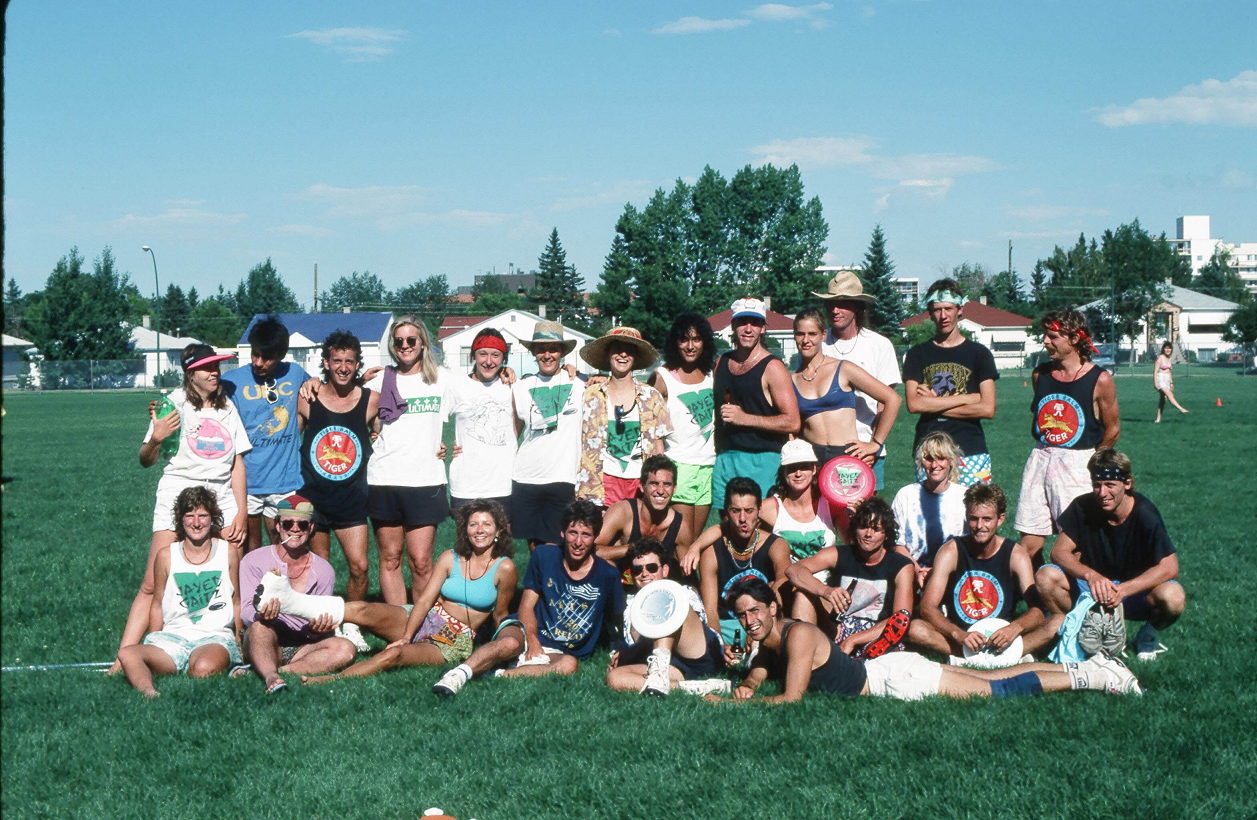 by Scott Lewis, with Craig Woods
by Scott Lewis, with Craig Woods
A subculture operates like a living organism. It is born under the right conditions and has a natural lifespan, after which it either fossilizes, dies, or changes into something else.
We know when the subculture that incubated the Vancouver Ultimate League first started to coalesce.
In September 1986, somewhere between 8 and 13 people organised a meeting at Hillcrest Park to form an ultimate league after a disc golf tournament at the nearby Little Mountain disc golf course. Alas, precisely who was there is lost in the mists of memory. (See sidebar "The Meeting that Kicked Off the VUL").
But what we do know is that out of that meeting came the very first edition of the Vancouver Ultimate League, comprised of three teams: the Nerf Terf Burners, the Flaming Red Sallies, and the Fringe. Each team started with five players, and promised to recruit more to ensure they would have at least five players on the field for each scheduled game when the league began play.
The Meeting that Kicked Off the VUL
Here’s an excerpt from the speech Carlo Giuliano delivered when he was inducted into the VUL Hall of Fame.
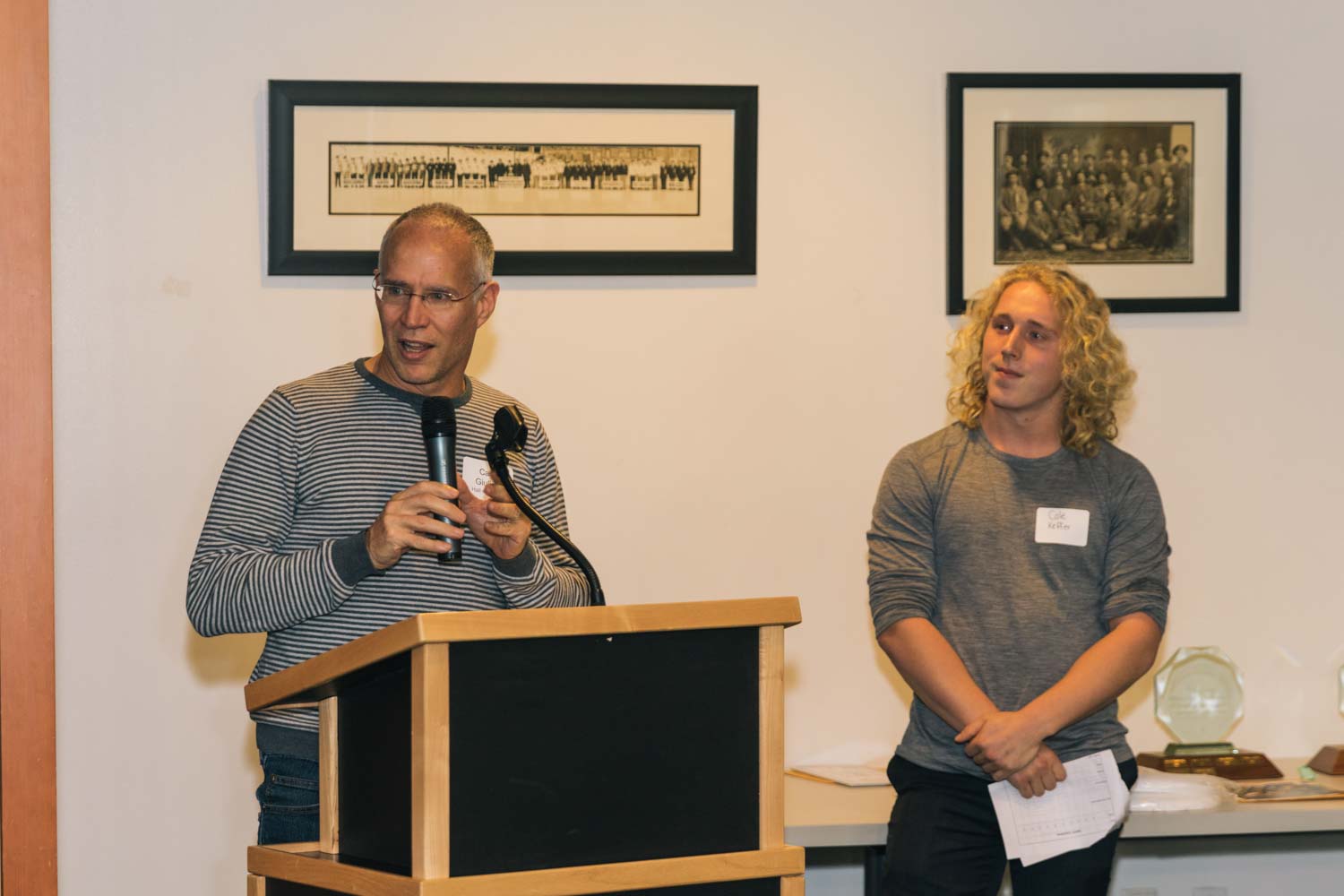 "This seems like the right occasion to bring out a piece of paper I have kept in my files for almost 30 years now. This is something I wrote in 1988, two years after the league was founded. At that time I tried to write down, from memory, a list of the people who were at the September 1986 meeting that founded the Vancouver Ultimate League. There are 13 people on my list. Five of those have question marks. The eight I was sure of are: Myself, Myrna Monck, Darryl Grigg, Jennifer Newman, Jo Playfair, Adam Berson, Doug Grant, Julia Daley.
"This seems like the right occasion to bring out a piece of paper I have kept in my files for almost 30 years now. This is something I wrote in 1988, two years after the league was founded. At that time I tried to write down, from memory, a list of the people who were at the September 1986 meeting that founded the Vancouver Ultimate League. There are 13 people on my list. Five of those have question marks. The eight I was sure of are: Myself, Myrna Monck, Darryl Grigg, Jennifer Newman, Jo Playfair, Adam Berson, Doug Grant, Julia Daley.
The five names I wrote down with question marks are: Steve Oldenburg (at his VUL HoF induction in 2015 Steve denied he was there), Steve Madigan, Liam Robinson, Matt McCutcheon, Jim Brown (who in 2015 was unable to remember whether he was there).
These people gathered to organize a league, ironically, because we didn’t have a reliable turn-out for the pick-up games we all loved to play. Our solution was to divide ourselves into 3 teams and appoint 3 captains. In my mind, it was those captains that did the hard work of getting the league started because they took on the responsibility to get a team on the field for each scheduled game. Darryl was captain of the Fringe, I believe Adam was captain of the Nerf Terf Burners, and Jo Playfair was captain of the Flaming Red Sallies. They were the people that really got the league started.
And it worked. We had regular, games, and more people came out because we had regular games. A couple of years later, when I was league coordinator for a year, we had seven teams. Below my list of founders I wrote 'Finding people to play a game of ultimate is no longer a problem. So on to new problems.' "
But of course the Vancouver Ultimate League didn’t suddenly appear out of the blue. What laid the groundwork for that foundational meeting?
Some might argue we should look all the way back to the early 20th Century when Ivy League students started tossing around tins from the Frisbie Pie Company, or to that day in 1947 when inventor Fred Morrison used a mould of his own design to make the very first plastic flying disc, or to 1967 when, using rules they had made up themselves, the student council from a New Jersey high school took on the school newspaper staff in the very first game of ultimate.
Sticking to British Columbia, we can point to 1974, when, at Willows Beach in Victoria, a group of friends started regularly playing a game of their own invention they called Frisbee Football, or to Sept. 22, 1979 when the very first game of ultimate in B.C. was played as part of a multi-disc sport tournament at Kinsman Gorge Park in Victoria, or to 1982 when the Victoria Flying Islander became the first ultimate team in the province.

No doubt all of these played a part, but it was the mixture of local veterans coming over from other disc sports, fertilized by newly arrived Vancouverites like VUL Hall of Fame member the late Doug Grant, and further enriched by the occasional newcomer who happened to come across the sport by accident, that made it happen.
Outside of the few dozen people who had played pickup at Kits Beach or participated in that first tournament at Jericho, when the league was founded in 1986 almost no one in Vancouver had even heard of ultimate. Fortunately, the nascent Vancouver disc community had developed good relations with the Parks Board through the lobbying for and the construction of the Little Mountain Disc Golf course, so when the Parks Board was approached about allocating field space for ultimate, in spite of some objections from other sports they opened up some slots at nearby Hillcrest field.
Needless to say, getting things organized was much different in those pre-internet days. There was no e-mail for contacting players, no Facebook to use to create a team or league page, not even voicemail. By 1986 some people had answering machines, but many still did not, so the method used by the league to communicate with players was to contact captains who then had the responsibility to contact their team members, often using a phone tree. One of the responsibilities of the early League Coordinators was to photocopy the schedule and show up at games to hand out copies to captains who would distribute them to the players. It was a relief for all when after a few years the league was able to set up an answering machine anyone could call and listen to the recorded greeting which was the schedule, eventually upgraded to a voice mailbox message.
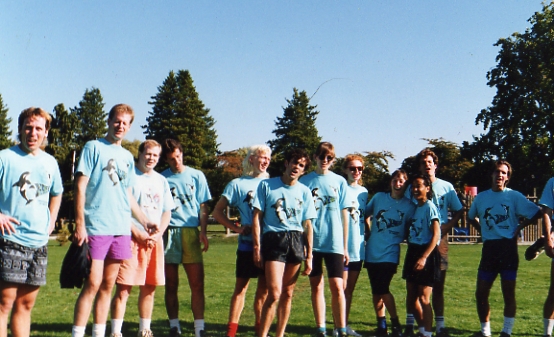
And an interesting crew those pioneers were. It takes a particular type of personality to get involved in a subculture, particularly in its early days. You need to be an innovator, a risk-taker, someone who takes psychological sustenance from being part of a shared experience outside of the mainstream. Although some of the early VUL players came to it by accident or though family members or romantic partners, most were exactly that type of person, someone who would seek out an unknown sport and allow it to take over their life. One wonders how many of the original VUL players would have become as involved with ultimate if they had been born thirty years later; most likely very few, as these days ultimate is far too mainstream to have interested them in the first place.
The "Sallies"
The Discombobulators, founded in 1991, may be the oldest surviving team in the VUL, closely followed by the Karmavores, but even today, several years after their demise, the Sallies retain a special place in VUL lore.
To start, they were one of the three founding teams in the league, using the moniker Flaming Red Sallies. (Somewhere over the years the “Flaming Red’ quietly slipped into the mists of history.) For their entire existence they were one of the top teams in the league, with many members of the VUL and Ultimate Canada Halls of Fame passing through their ranks.
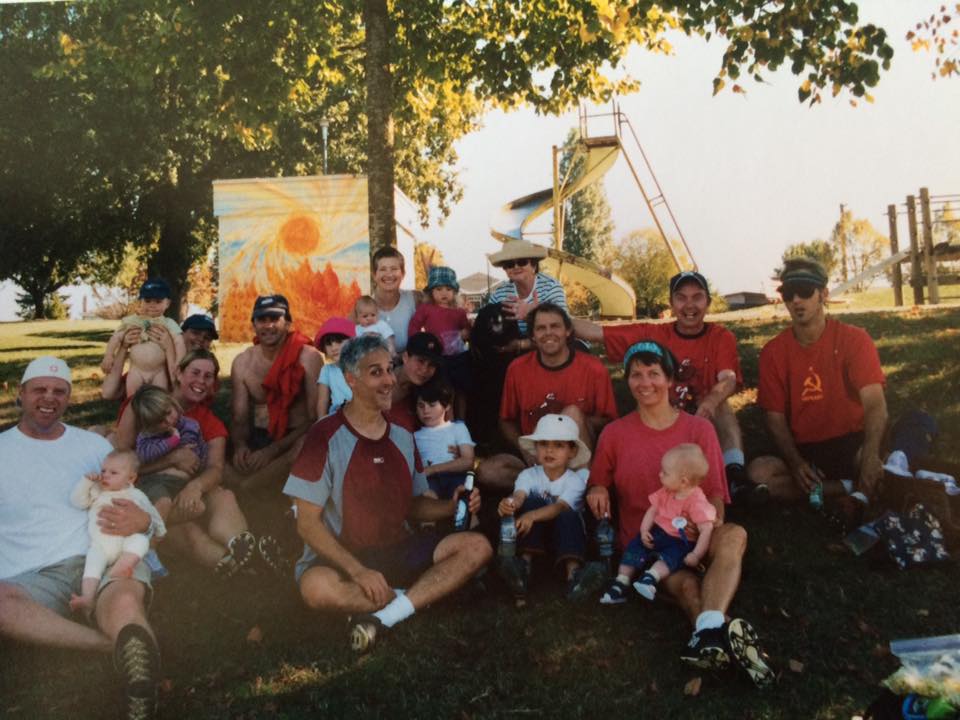
And the Sallies weren’t just pioneers in being the first Vancouver team to compete in a national championship. They also led the way in another important trend that transformed the VUL in the mid-1990s.
Until then, it was very rare to see children on the sidelines at games, but all of a sudden, it seemed, the couples who comprised the majority of the players on the Sallies started having children, and plenty of them. For the first time you had to worry about falling over a stroller on the sidelines if you chased a disc out of bounds, and you had to be careful during your warm-up for an upcoming game not to trip over a youngster who had wandered onto the field..
The wily Sally vets used their parenthood to their advantage. ‘Kid timeouts’ were sometimes called during games, though usually only after the Sallies had used up their regular timeouts. And the teams made up of childless players got used to being the ones that moved fields between games, given that moving the Sallies and their entourage was a major exertion, or at least that’s how it was portrayed when necessary to avoid moving.
Before long the Karmavores had started having kids too, and the trend quickly spread to the other teams made of older players. Today you can find a number of the kids who spent large parts of their childhoods on the sidelines in the 1990s themselves playing in the VUL.
The developing ultimate subculture carried a very countercultural, granola image. Yes, tournaments like Flower Bowl were becoming regular annual events and teams were being established at UVic, UBC, and SFU even as the BC Disc Sports Society was receiving provincial recognition, but ultimate was definitely still regarded as an outsider sport, both by those who played it and by the outsiders who happened across it. (One recruiting catchphrase used in those days was that ultimate was ‘a sport for jocks who hate jocks’.)
To the established sports ultimate was a bit of a joke which stole valuable field space and resources that should have been theirs, and any media coverage ultimate did manage to get was usually done with a bit of a snicker. But that didn’t discourage the VUL’s development, in fact it probably encouraged it, reinforcing the sense of separateness which feeds a subculture.
But subcultures exist in the real world, hence are always negotiating with outside institutions and structures of authority. In 1987, word filtered in from back east that some people from Ottawa were planning to hold the first ever Canadian Ultimate Championships. There wasn’t enough notice for Vancouver’s open touring team to make the trip, but the Flaming Red Sallies decided to step up and head to the event to represent British Columbia. They headed east with a total of nine players, including VUL Hall of Famer Tamara Mackenzie, and managed to finish a respectable 6th in the Open division (See 'The Sallies' sidebar for more).
The developing subculture was already becoming part of the recognized systems of sport. This is a central paradox that subcultures deal with; at the same time as they thrive on separateness, they also crave access to resources from outside and seek recognition from the mainstream, even though those resources and that recognition are threats to the continued existence of the subculture itself. These dynamics are why subcultures are never static, as they are continually renegotiating their relationship with the outside world.
So what would you have seen if you headed down to Hillcrest Field in 1988 on a league day? Actually, the first sense to be activated might have been your nose. One of the first league sponsors was a substance called Tiger Balm which was purported to soothe aching joints and sore muscles if you spread it on your skin. Plenty of free samples were handed out at games, so on a hot day an unmistakeable pungent redolence would waft above the fields as sweat and essential oils combined.
If you had come on the right day, you would have seen some of the TV trucks so common on Vancouver streets. Through their community channel, Rogers broadcast a number of league games in the late 1980s. For some years reruns of the games would pop up at random times on community TV channels across the U.S. and Canada.
One ‘granola’ element formed the core of the developing subculture was the concept of Spirit of the Game. Even the group of ‘rebels’ inside the generally left-leaning VUL who formed a team called Log It Burn It Pave It – yes, they were mostly engineering students – were one of the most Spirited teams in the league. And Spirit turned out to be a key catalyst for the demographic change which would expand the VUL beyond its roots.
The fall season in 1989 we saw the appearance of teams based at SFU and UBC, as well as a team of youngsters recruited by VUL Hall of Fame member Steve Oldenburg to play as the Pink Lungs. Up till then most members of the VUL had come to ultimate as adults, but suddenly there were younger players who had already played the game, sometimes very well, before they even got to the league. The B.C. Disc Sport Society’s Outreach Program had made great headway introducing disc sports in general and ultimate in particular into schools, and a big part of the pitch that won the schools over was that ultimate taught sporting behaviour, in the form of Spirit, as a part of the rules. (Of course, that the equipment necessary to play was so cheap didn’t hurt the cause...)
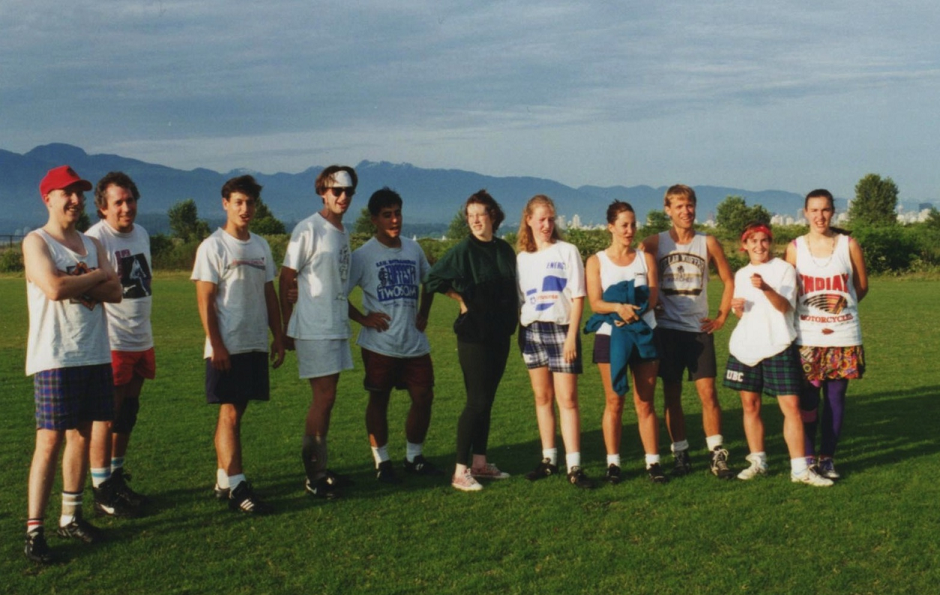 The first B.C. High School Championships were held in May 1991 with five teams, and when two teams made up of high school kids, the Funky Chickens and Disc Dragons, joined the VUL in the summer of 1992, this really marked the end of the first phase of the VUL, its childhood if you like.
The first B.C. High School Championships were held in May 1991 with five teams, and when two teams made up of high school kids, the Funky Chickens and Disc Dragons, joined the VUL in the summer of 1992, this really marked the end of the first phase of the VUL, its childhood if you like.
At first the older VUL vets were able to hold their own against this young, fast, and fit crop of youngsters, but eventually the new arrivals started to improve their throwing and learn the strategies necessary to win. And win they did! The players from these two teams formed the core of touring teams that ended up capturing a number of national and world championships over the succeeding decade and a half. Importantly, they were just the beginning of a constant supply of young players that continues to join the league every year, something the VUL has respected and encouraged by developing a junior division.
Another factor that had marked ultimate as an outsider sport right from the beginning was something quite unusual in sports in those days; a shared sense that it was important to ensure that the VUL be as co-ed as possible. The league was always very encouraging to new female players. (Yes, in those days the league was very encouraging to any new recruit, but this was especially true for women.)
The VUL had started with the requirement that there be one woman on the field, then two, and finally settled on the long-standing format of at least three of each gender on the field in 1994. From the beginning, it was the responsibility of each captain to make sure his or her team met the gender requirements. It wasn’t always easy in the early years, causing some defaults and making any woman who was willing to pick up for another team (with the consent of their opponents) VERY popular.
There was some resistance when the league moved from 6-1 to 5-2, but a clever ploy turned that on its head with the formation of a team called Ms. Alenious that always played with at least five women on the field instead of five men. (See 'Ms Alenious' sidebar). The Ms. Alenious experiment was successful for the women on the team, making them into better players individually and collectively, and it was a success for the VUL as well. Given their example, within two years the league had switched to current 4-3 format with little opposition.
Ms. Alenious: Playing with 5 Women and 2 Men in the Early 90's
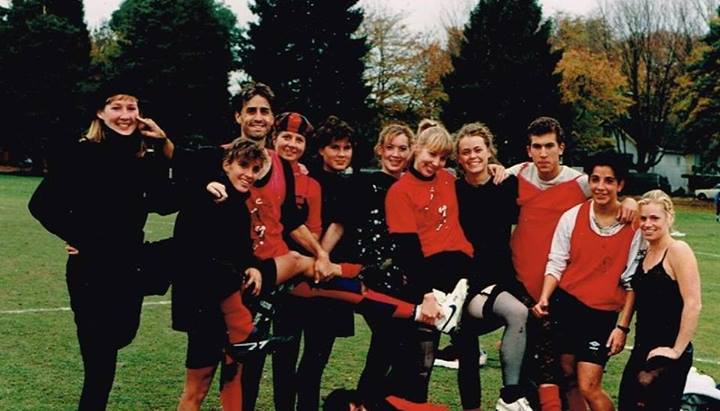 The Vancouver women’s team, then called Spin Sisters and in the first stages of building the GOO/Prime dynasty which went right to the top of Women’s ultimate, wanted to both make a statement about the league gender rules and get more playing time against top level opposition. So nine of their members plus their coach Laurin Hummelbrunner, longtime VUL player Josh Berson, and a newbie called Dan formed Ms. Alenious with the intention of always playing five women on the field.
The Vancouver women’s team, then called Spin Sisters and in the first stages of building the GOO/Prime dynasty which went right to the top of Women’s ultimate, wanted to both make a statement about the league gender rules and get more playing time against top level opposition. So nine of their members plus their coach Laurin Hummelbrunner, longtime VUL player Josh Berson, and a newbie called Dan formed Ms. Alenious with the intention of always playing five women on the field.
After due consideration of the difficulties they might cause for other teams by concentrating so many of the top female players on one team, they decided to enter B Pool in the 1992 Summer League and won handily to move up to A Pool, perhaps aided by wearing lingerie on the field, men included.
“The lingerie was a tactic to throw the youngsters off their game,” claims team member Val Hansen. “There were a lot of blushing 20 year olds across the field. We were highly successful in the B league, winning many games with our killer cup on Zone D, which became a strength for our team in women's ultimate tournaments.”
“We knew that our message of gender parity though modelled behaviour was only going to be well-received if we won,” added Josh Berson, “so we played our asses off. Over my 25 years in the VUL, playing with Ms. Alenious was definitely a highlight, a moment that still makes me proud of our community.”
As the league entered its adolescent growth spurt in the early 1990s, there was another change in its demographics that reflected changes in the makeup of the city itself; the increasing number of non-white ultimate players, many of them the children of immigrants.
To the credit of the VUL, there have never any issues with racism during its 30-year existence. Reflecting the city around it, one’s racial or ethnic background has never been an issue in any respect, but still, there has been quite a change in a relatively short period of time. There is no one better situated to comment on this than long-time VUL member Kelly Mah, who has been the mainstay of North Shore adult ultimate for the last quarter century. (See sidebar 'The Shift of Race Representation'.)
The Shift of Race Representation
A few years ago I was talking with Kelly Mah at an Ultimate Day in Vancouver event, and as we watched the steady flow of young players of all skin colours, he happened to comment that he remembered when he was one of only a few Asian players in the league. I was able to immediately name them all.
 I talked to him recently about the changes he has seen.
I talked to him recently about the changes he has seen.
“When I started playing ultimate in 1988,” said Mah, “there were very few Asians playing the sport in Vancouver – myself, Khai and Kwan Foo, Theresa Chow, maybe a few others. The VUL was an adult league at the time, but as this changed due to the Outreach and high school programs bringing ultimate into schools, it started a long slow process that eventually led the VUL to reflect Vancouver’s demographics.”
“Fast forward to 1998-2002, when Art Hawkins started Elimination Eights. There still weren't many Asians in the VUL at the time, but I decided to compile a team of them to play in the E8s, in other tournaments, and eventually in the VUL itself. We used any number of names, Dim Sum Club, Asian SensAsians, Aiya!, IntoxicAsians, among them."
"Even then, I had trouble finding enough Asians to field a team for these tournaments and the league. I had to expand the criteria to Asian, or had slept with an Asian. This opened up opportunities for those with Asian significant others, including of course, the legendary Art Hawkins himself.”
“Fast forward to today, and it's noticeable how many Asians there are in the VUL, directly reflecting the makeup of the population of Vancouver. The VUL should be proud to know that it's always instilled the SOTG when it comes to equality and inclusiveness. This, and the focus on remaining a recreational co-ed league, has made it such a welcoming place for new players of all skin colours and origins.”
The Peak of Cheers
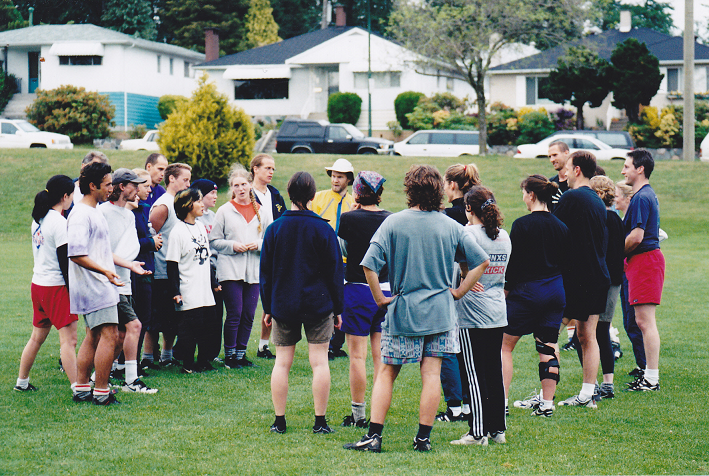 One thing that would amaze the younger players of today was how seriously post-game cheers were taken during the early years of the league. After the game each team was expected to make up a cheer with references to the game, usually an adaption of a popular song, and deliver it from memory. (Even if you hadn’t won the game, you could still win the cheer.)
One thing that would amaze the younger players of today was how seriously post-game cheers were taken during the early years of the league. After the game each team was expected to make up a cheer with references to the game, usually an adaption of a popular song, and deliver it from memory. (Even if you hadn’t won the game, you could still win the cheer.)
Long after ultimate in other locations had moved on to new forms of post-game celebration like Spirit circles, the VUL stuck with cheers, a trend that reached its peak by the mid-1990s, when some teams took it so seriously that there were a few epic cheer-offs, with performances more than five minutes long based on songs like American Pie and Bohemian Rhapsody. But eventually the stress of trying to come up with a new cheer for a team with a name that didn’t rhyme with anything that you had already played seven times in the last year became too much, and cheers started to disappear.
With the large influx of new players who were already familiar with the game as well as the newbies attracted to the game by friendship networks, the growth was rapid, from 24 teams in summer league in 1992 to 250 in 1998, and new nights and divisions were constantly being added. However, such growth, even though it is almost always craved by most members of a subculture as they look to spread the gospel to the uninitiated, also makes it harder to maintain the subculture. When it reaches this point, a subculture is well on the way to one of two fates; stagnation or absorption by the mainstream.
For a while the VUL maintained some aspects of its original quirky character – among the fads popular in the 1990s were multi-coloured painted toenails on both genders, and men wearing skirts – and the post-game cheer remained vital. (See 'The Peak of Cheers' sidebar.) Through the mid-1990s there were still a substantial number of people for whom life revolved around ultimate, playing multiple nights a week in the league plus in tournaments on weekends, highlighted by those summer weeknights playing at Jericho followed up with a post-game meal on the veranda at the Sailing Club.
But for most of the newcomers, ultimate never became a subcultural choice; it was just a fun night out, a form of recreation the same as playing softball on Tuesday nights. Inevitably, the character of the league began to change, particularly as the split into multiple divisions and nights meant the VUL members no longer all know each other the way they had used to. Parties had been another important part of the ultimate subculture through the mid-1990s, but even as the number of people involved in the league increased so greatly, attendance at the parties actually began to decline, a further sign that the original subcultural impulse was losing its impetus.
Jeff Malmgren At the Helm
The arrival of Jeff Malmgren as League Coordinator marked a sea change for the VUL. Here’s how he remembers the experience.
“When I applied for the coordinator contract the league was in an interesting place. It had grown rapidly and was quickly moving beyond the 'men in skirts' stage. The number one issue for the board was how to maintain Spirit in the face of ongoing growth, much of which was now coming from people who had a background in other sports, and sometimes brought their attitude with them. At the same time, the growth made managing the league more of a challenge than it had been up to that point.”
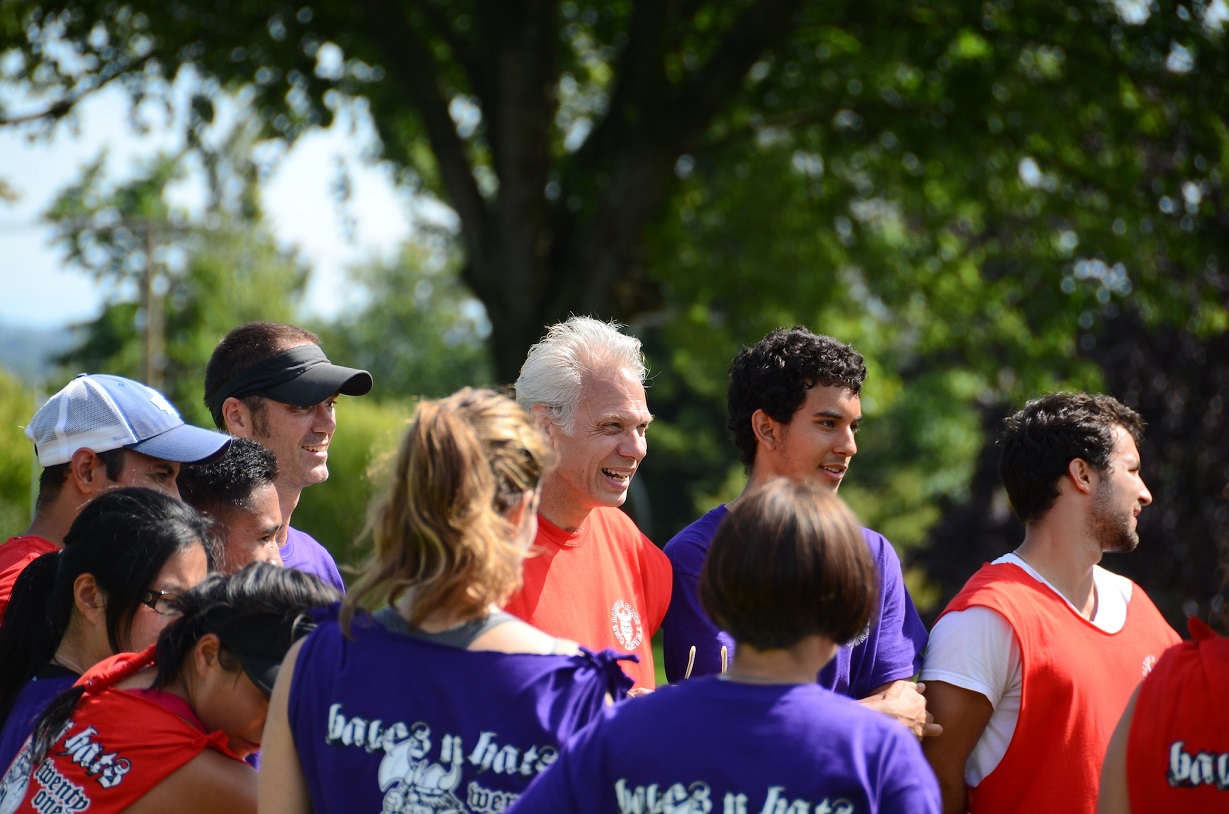
“I came a little bit out of the blue, only submitting myself as a candidate on the last day. Since some people allied to the previous management had put in a joint proposal, most people thought it would go to them. I'd been around the league for a few years, but certainly wasn't playing at their level, nor was I anywhere near as well known as they were."
"I brought a fair bit of experience in sport league management, along with a business and communications background and a pretty good knowledge base around working with boards and not for profit societies. But what I later heard from the board was that what made them choose me was that I had a clear vision of what I saw as the issues in the league and how I thought they could be addressed. Given that they weren't a board that was mature enough yet to define vision and guide direction, it was exactly what they were looking for. Also, I think I took the league on in its teenage years, and I knew what it was like to have teenagers, that is, I brought an ability to say no that was, although sometimes annoying, probably pretty valuable at that point in time.”
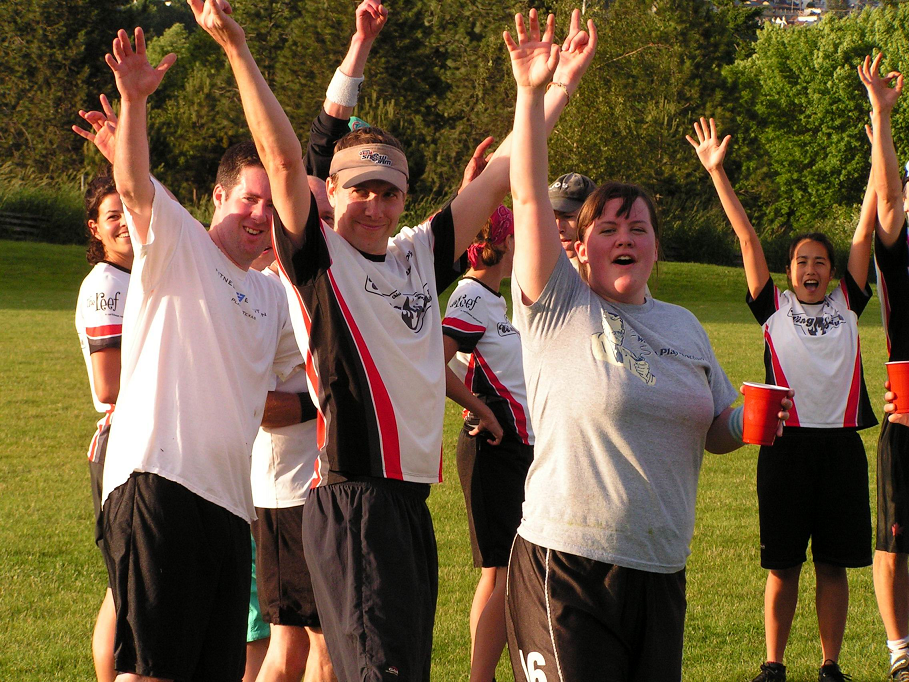 “Spirit was a critical issue for me, and its maintenance and growth were a big part of my vision. What I saw was that, even in the few years I'd been in the VUL, the opportunity to play with more experienced players had diminished as more and more teams came in as a group, from another sport or another league, etc. So I wanted to create more and better opportunities for the organic mentoring on which the league had been built to flourish."
“Spirit was a critical issue for me, and its maintenance and growth were a big part of my vision. What I saw was that, even in the few years I'd been in the VUL, the opportunity to play with more experienced players had diminished as more and more teams came in as a group, from another sport or another league, etc. So I wanted to create more and better opportunities for the organic mentoring on which the league had been built to flourish."
"The Spirit Hat week concept came from that. The first week of the season was devoted to four nights of hat play, and all newer teams were required to enter all of their players, and all returning teams required to put forward three players. I made this a condition of registration, which was interesting unto itself. Nothing I did in my time at the VUL was harder than getting people to sign up for the Spirit week, but it just worked so well. Even though getting people to sign up got a lot of annoyed responses, talking to people at the fields afterwards I heard that this was the best thing they'd ever done at the start of the season, newbies and vets alike.”
“We also brought in a mentoring program which placed veterans with newbie teams. It was sponsored by Gaia and really successful."
"Pretty much every board I served under at some point asked me how I planned to grow the league, to which I always responded by asking whether they really wanted to grow the league. They would be taken aback and go into evangelical mode, saying that they just wanted to see more people playing. I would then ask if it was more important to grow the league or to maintain and build Spirit and ensure the league ran well. Then they would usually say those things were probably more important, that they would rather have a smaller, well run Spirited league. So I never worried about growth, just about making sure that, no matter what size the league was, the Spirit remained high and the league was well organized and well run."
Another factor that changed the culture of the league was an outcome of the Outreach and high school programs, as well as the advent of coaching and training innovations; the positioning of ultimate as a serious competitive sport. Vancouver open and women’s teams began winning first national and then world championships, with the Furious George and Goo/Prime dynasties ruling the world for a number of years. This pulled many of the most-committed ultimate players away from the VUL as their schedules became too busy to commit to league play, further defining the VUL as a recreational league. Even the overwhelming success of the 1997 WFDF World Championships, which were held at UBC with the help of over 400 staff and volunteers mostly drawn from the VUL, furthered underlined the different focus of competitive and recreational players.
Until 1998 the VUL had operated, sometimes uneasily, under the umbrella of the B.C. Disc Sports Society, but based on the new heft that had come from the rapid growth an independent Vancouver Ultimate League Society was formed in 2000 to oversee the league. The adolescent reliance on others was over; the league was now all grown up and ready to strike out on its own.
Something else had become clear. With all the growth, no longer could the VUL rely on untrained part-timers to run things. In order for a league of this size to function at all, it would have to leave behind any pretension to subcultural reliance on insiders and internally developed practices. It needed to professionalize its administration and bring in people trained and experienced in running an organization of its type and size, so the decision was made to hire a full-time professional League Coordinator in 2001.
A member of both the Ultimate Canada and the VUL Halls of Fames, Brian Gisel has been at the centre of all things ultimate in Vancouver for the last quarter century. Gisel was a member of the VULS Board of Directors at the time; here’s how he remembers the process.
“We interviewed three candidates for the League Coordinator position. I remember that we were basically going to give the job to the incumbent group, but Jeff Malmgren came in and blew us away with his ‘vision’ for organizing and managing all the growth we had just gone through. It was impossible not to give him the gig.”
“Jeff proved us right and he managed to formalize the organization of the league in terms of registration, communication, financial tracking and the creation of many of the leagues rules and structures that remain to this day. While the VUL had gone through the "STORMING" cycle of growth, it was Jeff that helped the VUL achieve the "NORMING" part of the cycle.” (See sidebar for more)
One of the key relationships Malmgren developed was with the Vancouver Field Sports Federation. The VFSF acts as a liaison between the Park Board and Vancouver field users, advocating for field improvements on their behalf. At the time there was a lot of competition between sports for fields and a lot of mistrust around the new to Vancouver installation of turf fields. With ultimate perceived as an honest broker, Jeff used the opportunity to take on the position of President of the VFSF, building ever stronger relationships with other sports and with the Parks Board itself. There is no better manifestation of this initiative than the ultimate fields that were built in Oak Meadows Park in 2007; they were a collaborative effort between the VUL, the French School Board, and the Parks Board.
Malmgren also made several structural changes in the league. The emphasis was switched from winning to Spirit as much as possible by measures such as having bigger awards for Spirit than for winning divisions, and the traditional A, B, and C pools on separate nights were replaced by having all skill levels play on every night. He also replaced the way clinics had been delivered by touring teams in favour of taking them back in house under the direction of Mike “Spud” Fleury (see sidebar), a system which worked much better for the league and which continues to flourish to this day.
By 2006 the League was becoming too big for one person to manage. The Board and Jeff decided it was finally time to hire additional help. They spent a lot of time developing clear guidelines and job descriptions to support this major change, and in 2007 Jeff became the Executive Director and Dan Reeve was hired as the new League Coordinator. This shift also allowed the Board to step even further back from day-to-day operations, and focus more on the long-term goals of the society.
With his new found time, in 2007 Jeff introduced the first Ultimate Day in Vancouver. A major kick-off event to start Summer League, Ultimate Day included the large Captains Meeting, a ‘trade show’ where VUL members could meet partners, sponsors, and tournament organizers, indoor workshops & info sessions, and series of outdoor clinics. It has become one of the VUL’s main events for the year.
All of the changes introduced by Jeff helped revitalized the organization as a whole. When Malmgren arrived, it was difficult to find people to run for the Board of Directors and even harder to get enough people to come out to the AGM to make quorum for the elections. During his time, Jeff and the Board focused on developing and improving the governance and management of the organization. At the AGM, the VUL now consistently had competitive elections with engaged members participating in discussions and votes.
Spud and the Clinics
When the VUL was first formed, training newbies was straightforward – you recruit them, you teach them how to play. But by 1990, people were starting to find the league without being recruited, so these players were put on the Discombobultors, where captain Scott Lewis taught them the game. This was sufficient for a few years, but with the onset of explosive growth the league required a new system, so the first VUL clinics were scheduled, at first just for newcomers but before long also for experienced players looking to improve their game. These clinics were led by members of the Vancouver touring teams, which worked out well for the VUL but also served two purposes for the touring teams. They could use the fees they were paid by the league for running the clinics to offset the costs of traveling to tournaments to represent Vancouver, plus they could spot promising up-and-comers who might someday make the touring teams and give them special encouragement and training.
But by the turn of the millennium, even this new system was feeling the strain. Not every top level player who makes a touring team is a good teacher, plus the sheer bulk of new recruits was overwhelming the touring players who were able and willing to run the clinics. So as part of the initiatives brought in by Jeff Malmgren after he became League Coordinator, he needed someone to run a dedicated clinic system on a consistent basis.
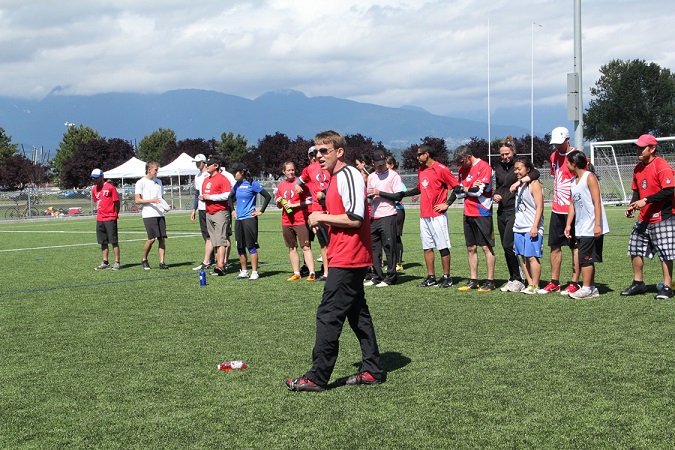 Jeff has a great gift for evaluating people, so it is no surprise he reached out to Mike Fleury, better known in ultimate circles by his nickname Spud, to take over the clinics. Spud had been recruited to ultimate by Fi Campbell to join the Flaming Red Sallies in 1987, not long after he arrived in Vancouver from his home town Calgary.
Jeff has a great gift for evaluating people, so it is no surprise he reached out to Mike Fleury, better known in ultimate circles by his nickname Spud, to take over the clinics. Spud had been recruited to ultimate by Fi Campbell to join the Flaming Red Sallies in 1987, not long after he arrived in Vancouver from his home town Calgary.
Mike says that Fi told him that ultimate was the sport made for him, and she was right; he found a home, even a surrogate family. You can hear the warmth in his voice when you ask him about the people he has met over the years through ultimate.
“So much of what I have tried to instil in the people participating in my clinics has roots with the many great people I met through ultimate -- Mark Lucier (mentor extraordinaire), Josh Berson, Anja Haman, Jen Nicholls, Joe Playfair... So many! And I must give a special shout out to Peter Bottom and Jeremy Giles for all of their support and energy they gave me while helping me out with clinics.”
“The first clinic I led was a beginner throwing session. It was before we had on-line registration, so I was surprised, and a bit overwhelmed to have about fifty folks show up. I recall being quite nervous, unsure, and excited. I did have a plan but when it came to the details I remember I kept wondering things like "What am I forgetting?" and ‘Is that right?’ And when I got up to demonstrate the grip on a backhand I had to stop and ask myself, ‘How the heck do I hold this again?’”
“The most unusual clinic was the first Super Clinic we ran; more than 300 people, 50 discs, and 30 mentors, all on four fields. I still giggle about Al Nichols running the throwing station with discs flying everywhere. Blissful mayhem.”
“I always get each group throwing before I begin the clinic itself so I can assess the skill and needs of the group. I try to keep it basic while always giving them things to strive for. It’s like planting seeds. {Spud is also a keen gardener.] They may not ‘get it’ today but it’s good for them to push their limits. I see each skill or strategy as another tool for their tool box.”
“With newbies, I am always sure to let them know that they are right where they should be at this point, so they don't worry about not knowing or understanding everything yet.”
“I'm not sure how many times I've said ‘Elbow. Forearm, WRIST!!’ There are somewhere between 12 and 20 clinics per year, and if I remember right I have only missed four in total over the years. And besides the VUL clinics I have branched out to teaching in schools and team sessions and private lessons, as well as leading teams and leagues in Colombia, Mexico City, Whitehorse, Victoria, etc.”
“I have been truly blessed as a result of Fi Campbell recruiting me all those years ago and then Jeff Malmgren giving me the chance to run the clinics”.
In 2008, Jeff stepped aside to hand the Executive Director hat to Art Hawkins, and Craig Woods stepped in as League Coordinator.
Art had originally started playing ultimate in 1991. He was an active league player, but also competed at provincial, national, and world championships. As his on-field participation started to slow down in the 2000s, his off-field contributions began to grow. He founded the Elimination 8’s tournament, a fundraising event where all proceeds are donated to local charities. And after a term on the VULS Board of Directors, he became Executive Director.
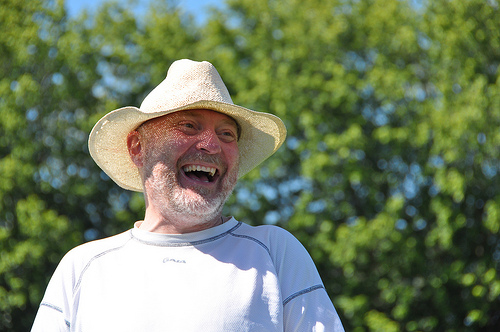 As ED, Art was instrumental in pushing forward a number of VUL initiatives, including strengthening the Mentor programs, increasing the focus on junior development, and working with Ultimate Canada to start the annual 24-hour Great Canadian Ultimate Game. One of his biggest legacies is the founding the Annual Awards Banquet. The VUL used to hand out annual awards during the summer party in August or September. But ultimate players like to party, and it was difficult to get everyone’s attention for the awards (and it interrupted the party).
As ED, Art was instrumental in pushing forward a number of VUL initiatives, including strengthening the Mentor programs, increasing the focus on junior development, and working with Ultimate Canada to start the annual 24-hour Great Canadian Ultimate Game. One of his biggest legacies is the founding the Annual Awards Banquet. The VUL used to hand out annual awards during the summer party in August or September. But ultimate players like to party, and it was difficult to get everyone’s attention for the awards (and it interrupted the party).
The 2008 year was especially challenging when the VUL announced the Female Spirit award would be re-named after a long-time member, Laurel Stroppa Atwood, who had passed away from cancer in 2007 (see Awards). Laurel was much loved member of the VUL, who like Art was known for her spirit and was heavily involved in the community during the 90’s and 2000’s. Art wanted a special event to celebrate individuals like Laurel. So in 2009, he launched the VUL’s first Annual Awards Banquet as a more formal gathering, and we’ve never looked back. It’s become an important event where we acknowledge and celebrate the many people who contribute to the VUL, including annual contributions and inductees to the VUL Hall of Fame.
Sadly, in 2010, Art lost his own battle with cancer, and he passed away in November of that year. At the AGM that year, the VUL announced that the Male Spirit award would be re-named after Art, and in the same month Ultimate Canada announced that the Great Canadian Ultimate Game would become the Arthur Hawkins Great Canadian Ultimate Game. The ultimate community truly benefited from the enthusiasm, dedication, leadership, and spirit that both Laurel and Art embodied.
Part of life as an adult is learning to live and work through loss and transition. The Board and LC Craig Woods worked together to steady the ship during the latter half of 2010. By early 2011, Craig had been promoted to Executive Director, and long time VUL member David “Speedo” Savory was the new League Coordinator. When asked to reflect on that time, Craig said: “A special shout out to Brian Gisel, the President that year, who with the Board helped carry the load during Art’s final few months. I felt very honoured to step into the big shoes left behind by Art, and to continue the traditions laid down by Jeff before him. I was inspired by the steady, kind, and measured way that Art managed the VUL as ED, and today I still follow many of the approaches that he introduced to me back then. I really enjoyed our 3 years together, and I still miss him.”
At the start of 2011, activity in the VUL was occurring on a number of fronts. Having grown from 2200 members in 1990 to 4000 in 2010, the single subculture and focus of the league had dispersed into multiple ones. Change was the new norm. Before we continue, let’s rewind to explore two sources of change: new fields and youth.
Fields are a-Changin
Around 2002 the Park Board and Fields Sports Federation hatched a plan to develop new artificial turf (AT) fields around the city. Over the next 12 years, a total of 8 new fields were built: Point Grey, Van Tech, Memorial, Jericho, Trillium (2), and Empire (2). In 2009 the Andy Livingstone fields were also converted from the old “carpet” surface into the new rubber infill surface, bringing the total number of fields to 10.
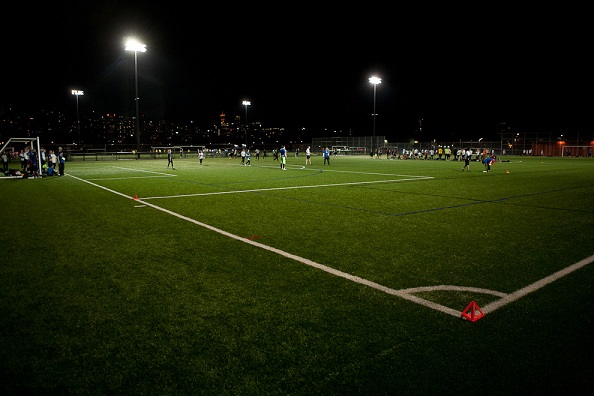 Artificial turf is valuable because it remains playable in the rain, and with lights can be used much more often than grass. Synthetic turf completely changed the type of play that was possible in the Fall & Winter months because games could now be played in the evenings when it was dark. This was a huge benefit for sports like soccer and ultimate, and the VUL was grateful to the Park Board and City of Vancouver for the investments required to build these fields.
Artificial turf is valuable because it remains playable in the rain, and with lights can be used much more often than grass. Synthetic turf completely changed the type of play that was possible in the Fall & Winter months because games could now be played in the evenings when it was dark. This was a huge benefit for sports like soccer and ultimate, and the VUL was grateful to the Park Board and City of Vancouver for the investments required to build these fields.
As could be expected, these new fields affected where VUL games were played. For over a decade the VUL had played many games at UBC. Players from the 90’s and early 2000’s will remember 8 ultimate fields spread across the rugby pitches that are just to the south of Thunderbird Arena. It was great to see so much ultimate in one spot, but those fields were expensive, and the commute was challenging for many players, so as new AT fields came online, the VUL slowly stopped using UBC fields for most games.
The other big change was the birth of the 5-on-5 “turf league” in the Fall of 2008. At the time, League Coordinator Craig Woods was trying to figure out how the VUL could use the new AT field at Van Tech High School. One option was weekend time for the Grass League so cancellations could be avoided after heavy rains. But one field wouldn’t have made much of a difference in a 90-team league, and youth soccer typically got priority on weekends. Another option was a weeknight league, but one field only supports 2 regular ultimate games at once, so that wouldn’t be much of a league. In the end, inspiration came from new local upstart.
In 2007 the Indoor Ultimate league had started in Vancouver. Inspired by indoor leagues in eastern Canada, they played 5-on-5 in a small gym. Players subbed on the fly rather than after a point, and the fast-paced game was popular. Craig realized that format could work on AT fields: if games were played across the field rather than lengthwise, the field could support four games rather than just two, doubling the number of teams that would participate. Thus the 5-on-5 Turf format was born. It has proved to be incredibly popular in Vancouver: from 16 teams that first Fall to 64 teams this year, plus a Winter Turf League that has grown to 88 teams - the VUL’s second largest league.
Will and the Juniors
In the early days of the VUL, almost all the participants had started playing at university or as adults, but this started to change around 1990 thanks to the Outreach Program run by the BC Disc Sports Society, which sent experienced players to teaching sessions primarily in schools but also at playgrounds and the like. By 1991 teams composed entirely of high school students began to sign up for the VUL, and the players on those teams became the core of the Furious George and Goo/Prime dynasties that took Vancouver right to the top of the ultimate world, winning many national and world championships.
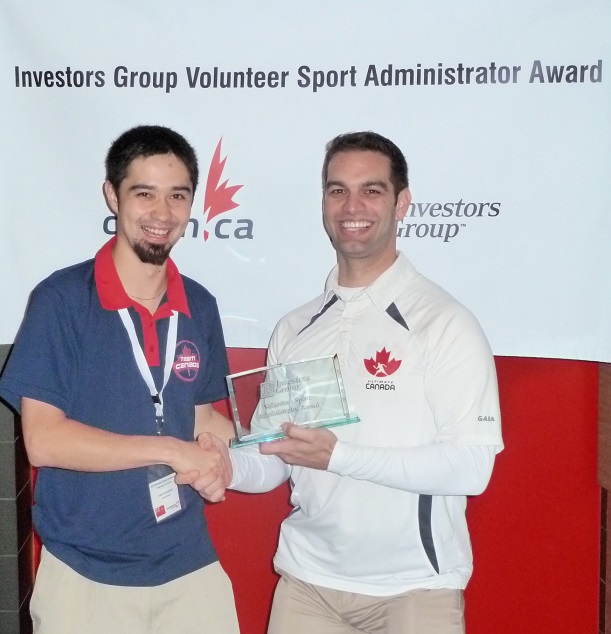 Meanwhile, teachers around the Lower Mainland, many players in or alumni of the VUL, started high school programs, and before long there were regular high school championships on the city and provincial level, a number of the winners of which went on to compete at and win age level national and world championships.
Meanwhile, teachers around the Lower Mainland, many players in or alumni of the VUL, started high school programs, and before long there were regular high school championships on the city and provincial level, a number of the winners of which went on to compete at and win age level national and world championships.
This decentralized system, based on coaching manuals and curricula developed by VUL players like Michael Firth, continues to work well to this day, but when Jeff Malmgren became the VUL Coordinator he saw a role for the league among the younger players and asked Will Arlotta to develop a Juniors program for the VUL itself.
Will was the perfect candidate having started working with Mike Kaweski on the BCDSS Outreach Program in 1994.
“I have always enjoyed giving kids the opportunity to play sports, so why not do it in a sport that I love?”
Jeff and Will started partnering to put on regular youth programs at Memorial Oval during the summer months. It started as pick-up ultimate with clinics, then became a Summer Juniors League. They also did some summer youth camps in association with community centres.
This continued to burble along, plus Carla Craddock started a highly successful Juniors program on the North Shore, but things took another step when Art Hawkins became Executive Director of the VUL in 2008. Art asked Will to help him run some additional Juniors programming, including a Junior Hat League and even a bursary program for players going on to local universities.
In 2011 Will finally started working for the VUL and since then the array of Juniors programs have only grown, encompassing a wide variety of dedicated leagues and skills camps. And more and more, elementary schools as well as high schools have been getting involved.
For Will, it is important to retain a special focus for the VUL’s Juniors programs.
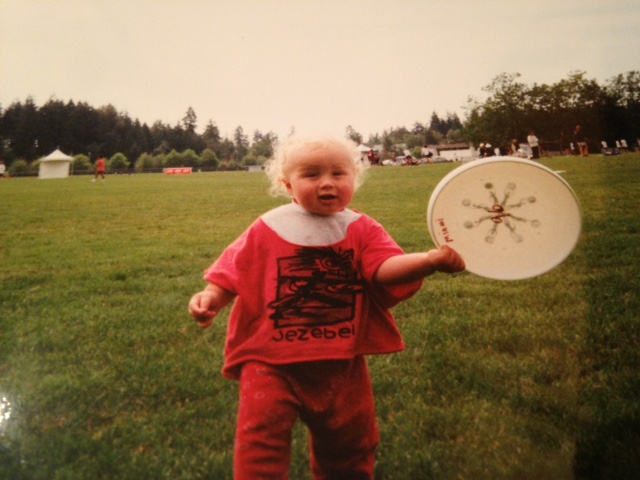
This is key. As with the participants in any sport, most ultimate players are recreational athletes who mainly play for fun, exercise and social connections, and the VUL sees these players as the future of the league. The VUL wants to make sure the youngsters not only develop a spirited approach to ultimate, but also develop the skills that will allow them to continue to enjoy the game, most of them in the VUL, for as long as their bodies let them.
But the impact of these efforts reaches beyond the casual players. If you want to really get the lowdown on the competitive players who have come out of the Lower Mainland, just ask Will. Odds are he has coached or taught them somewhere along the way.
“Almost all of the touring players that have grown up in the Lower Mainland have come through the youth programs either via the BCDSS/BCU or the VUL. These days, unless you moved here as an adult, you would have participated in these programs at some point, whether it was for casual play, clinics, tournaments, or even for some of the top touring youth teams.”
With such a robust and well-developed set of programs to develop young players, it is no surprise that Vancouver continues to produce well more than our share of ultimate players, be they recreational players who just enjoy getting out on the field with their teammates or top level athletes who want to make their marks on the national and world stage.
By 2010, the VUL had been on its own for a decade and had developed a pretty solid foundation. The youth initiatives that started in that decade are examples of the collaborative spirit common to many ultimate organizations. As a new ED in 2011, Craig Woods and subsequent Boards were inspired to continue this tradition.
After the VUL left the BCDSS nest in 2000, the BCDSS continued to serve ultimate and Disc Golf throughout the province, but by the end of the decade, the BCDSS began to struggle. A lack of volunteers and some differences of opinion between ultimate and disc golf members were creating challenges; the culture had become dysfunctional, and the VUL found itself returning to help an ailing parent. Woods had a personal interest in the situation: “I’d been involved with the BCDSS since 2002, including 3 years as President, so it was challenging for me to see their struggle and frustrations. In addition, from the VUL’s perspective, we wanted to see more action on the regional development of ultimate than the BCDSS had been able to deliver.”
After a number of mediated discussions, with the VUL’s support and the blessing of the Disc Golf Branch, the Ultimate Branch of the BCDSS eventually decided to separate to form its own provincial organization. The new BC Ultimate Society was formed in 2012; another child of the BCDSS was born. As with any birth, that was only the beginning. The VUL recognized the fledgling organization would need additional support to get off the ground, so grants were offered to help the BCU hire their first General Manager, Troë Weston, in 2013. In addition, after a few years on the VUL Board, Alex Davis joined the BCU Board in the fall of 2013 to offer his skills and experience. And when Troë became the VUL's League Manager in 2015, Brian Gisel took over as GM for BC Ultimate, a full 15 years after he joined the first Board of the newly independent VULS in 2000. I get by with a little help from my friends, they say.
Professional Ultimate
A new form of ultimate appeared in Vancouver in 2013 when the Vancouver Nighthawks became one of eight teams, and the only Canadian-based one, in the professional Major League Ultimate, followed a year later by the Vancouver Riptide in the rival AUDL.
(In reality, both leagues are technically semi-pro, in that they don’t earn full salaries as players. A few are well-paid but most receive only token payments, the main benefit being that training and travel costs are covered. Almost all the players on both the Nighthawks and Riptide play on the top Vancouver men’s touring teams, so the pro teams also provide another way for those touring teams to prepare for their amateur seasons, which get underway not long after the MLU and AUDL seasons have ended for the year.)
At first, the VUL was unsure what to do with the new league. Referees? That’s not ultimate! There was concern about a slippery slope away from traditional self-referred and spirited ultimate towards the cheat-if-I-can-get-away-with-it approach that can plague many other refereed sports. After much discussion, the instinct to collaborate prevailed. In many ways, interests were aligned: both organizations wanted to see the sport grow. And to address concerns about Spirit, the VUL felt it was better to engage than not; it was better work closely with the MLU and AUDL to ensure that Spirit was maintained wherever possible, than remain on the sideline and not be part of the discussion. It also didn’t hurt that the Nighthawks’ General Manager at the time was a fellow named Brian Gisel (remember him?), so the VUL knew it had an effective partner on the other side.
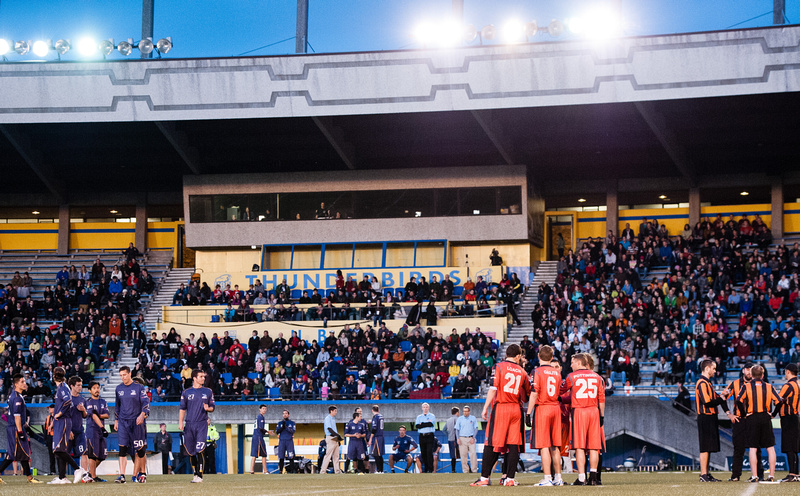
So far this has proved to be a positive choice. Spirit in the league, is, if anything, stronger than ever, and so far at least, Spirit has survived in the Pro leagues in spite of the presence of referees. It is not unusual to see a pro player overrule a call made by a referee in is favour if he knows it was incorrect.
Since 2013, the VUL has worked closely with both the Riptide and the Nighthawks. The relationships have been positive for everyone.
The main benefit for the pro teams is the ability to market their home games to VUL players and teams. There are ticket giveaways to VUL teams and captains, and Nighthawk and Riptide players make appearance at league events such as clinics.
The VUL benefits from the marketing brought about by promotional events at Nighthawk and Riptide home games, where attendance can reach 1500 people, many not currently involved with the VUL. At home games the VUL sponsors Player of the Game awards, awarded to players who demonstrate both skill AND spirit, and VUL merchandise is sold at all games.
And of course a number of the Nighthawk and Riptide players also play in the most competitive divisions of the VUL and its sister league across the Lower Mainland, bringing the experience and knowledge they gain in MLU and AUDL training and games back to the VUL.
On another front, by 2011 at the young age of 5, the Indoor Ultimate League was doing well. The VUL approached them to see if they wanted to work together in any way. Running a league can be fun, but it can also take a lot of effort. The VUL has a large infrastructure and a number of services that can ease the burden for smaller organizations. The two founders, Jeremy Keating and Jeremy Seakrait, loved their creation and wanted to see it continue, but also knew that they didn’t want to run it forever. The VUL initially helped with registration starting in 2012, and then eventually fully absorbed the league into the VUL. New Coordinators stepped forward to run the league and continue the unique traditions defined by Jeremy and Jeremy, and they were able to step back and just play.
A year later, in 2012, Jon Hayduk approached the VUL for assistance with the growing Misfit Youth Ultimate program. Started as a Vancouver development program for the elite Provincial club teams, Misfit had grown into a significant youth program of its own right, and it needed a home. The VUL wanted to increase its connections to youth players and expand the variety of its youth programs, so it was a good fit. In 2013, Misfit moved under the VUL’s umbrella and has thrived there every since. In 2016, the Misfit Girls team actually won first place at the Canadian Ultimate Championship, much to the chagrin of their opponent, the BC Provincial Team. Sometimes friends can enjoy healthy competition with each other, too….
A third and final example of the VUL’s desire to collaborate with others arrived in 2013. Professional ultimate arrived in town for the first time with the Vancouver Nighthawks of the MLU (Major League Ultimate). At first, the VUL was unsure what to do with the new league. Referees? How should we respond? See the sidebar for more.
Looking to the future
The VUL would not be where it is today without the many individuals who volunteered their time on the Board of Directors. Their efforts and steady guidance have been critical to the VUL’s success. Through the 90’s they handled a lot of the day-to-day tasks as the league grew rapidly. In 2000 they recognized the need to hire professional staff to manage the league. Six years later they recognized it was time to add another staff member, and Jenna Newman and others spent many hours working with Jeff to lead the organization through that next step.
The next change in focus started in 2011. That year’s Board of Directors was one of the more ambitious to be elected in a number of years. That group, led by President Brian Gisel and Committee Chair Carolyn Lefebvre, spearheaded the creation of the VUL’s very first 5-year Strategic Plan. With two full-time staff, the Board now had more time and capacity to focus on the long-term. Where did we want to be in 5 or 10 years? What should the organization focus on?
That Board and Staff set an ambitious goal of growing the number of people playing spirited and satisfying ultimate in Metro Vancouver from 6000 to 8000 players. Of those 6000 players, roughly 4000 were VUL members in 2011, and the rest were high school players and adults in other Metro Vancouver leagues. It was an ambitious goal, but it also was not about growth at any costs: “spirited” and “satisfying” were key aspects of the objective. The goal was also notable in how it was a slight shift from the approach taken by Jeff Malmgren, whose focus was not explicitly on growth. The Board felt the VUL could achieve the benefits of growth (sharing the joy of ultimate with others) while still maintaining quality programs and a high level of spirit.
Over the subsequent five years, the VUL pursued a number of activities each year to move towards that goal. Those included changes to leagues and events to address issues raised in surveys; more services for captains, women, and new players; fun activities like Spirit Tie; better communication including expanded use of social media; and building a new website. To help create and deliver all of those initiatives, the VUL added a third full-time staff member: Craig Kulyk joined as the VUL’s first Marketing Coordinator in 2012. Woods gives him props: “Craig has been instrumental in improving the reach of our marketing and communications and leading a number of important initiatives over the past 5 years.”
As we near the end of 2016, it appears the goal has been met! The VUL estimates there are 8000-8100 active players in Metro Vancouver. About one-third of the growth occurred outside of the VUL, and the VUL itself grew from under 4000 players to about 5250 players.
What do you do when you meet a goal? You celebrate! And then figure out what you want to do next. Throughout 2016, led by President Travis Smith the VUL Board and Staff worked on a new 5-Year Strategic Plan to begin in 2017. The new plan continues elements of the past plan, but focuses less on growth as the main goal and adds new areas of attention. There will be four areas of focus: Adults, Youth, Regional Support, and Leadership. Full details will be shared at the VUL’s Annual General Meeting on November 8, 2016.
So there you have it. Over the last thirty years the VUL made it safely through childhood, thrived during an adolescent growth spurt inside a subcultural milieu, and has now settled into a comfortable adulthood as a mainstream institution. Thanks to the reorganization process begun at the turn of the millennium and the hiring of full-time professional staff, the VUL is recognized as one of the best-run ultimate leagues in the world. Perhaps most importantly, the league is widely recognized as an established part of the city it inhabits, something unimaginable back in the early days when every conversation about ultimate seemed to start with explaining what it was.
I wonder where we’ll be in another 30 years?
For any errors or omissions, please email ED@vul.ca.
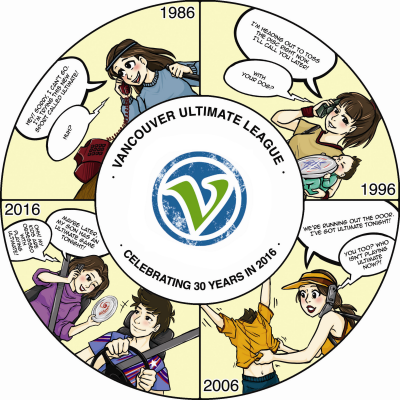 Photo Credits (click on all photos for larger view)
Photo Credits (click on all photos for larger view)
- Jayed Gaitz and Van Gogh in 1987. Credit: Sylviane Allard
- Vancouver's first tournament team, Vancouver Ariel Express. Credit: Scott Lewis
- The Rocky Mountain Whalers joined the VUL in the fall of 1988. Credit: Scott Lewis
- The Flaming Red Sallies. Credit: Scott Lewis
- Brian Gisel & teammates at Jericho in 1994. Credit: Kim Goodwin
- Ms Alenious. Credit: Scott Lewis
- Kelly Mah & friends at Babes N Hats 2016. Credit: Justin Ho
- Post-game Cheers. Credit: Scott Lewis
- Spirit 2005. Credit: Will Major
- Spud Fleury at Jericho. Credit: Joel Burch
- Art Hawkins. Credit: Craig Temple
- Turf League. Credit: Kurtis Stewart
- William Arlotta and Danny Saunders. Credit: BC Ultimate
- Young Cole Keffer Credit: Deanna Johnson
- Nighthawks at Thunderbird Stadium. Credit: Jeff Bell
- VUL 30th Anniversary Disc
